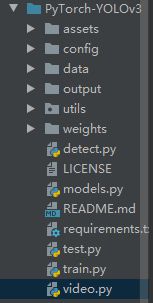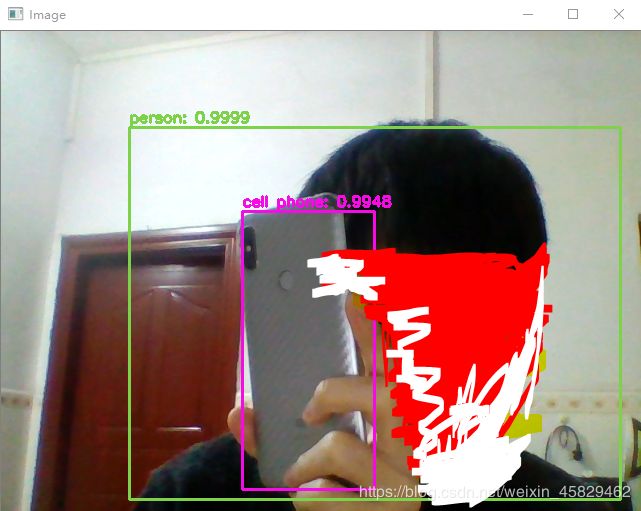window10下打开摄像头实现Pytorch-YOLOv3的实时监测
1、参考:
opencv调用YOLOv3模型进行目标检测
基于python3的Opencv(一)-打开摄像头显示图像
python+OpenCV+YOLOv3打开笔记本摄像头模型检测
2、配置:
笔者的运行环境为:
- window 10
- pycharm
- opencv-python
- Pytorch-YOLOv3
朋友们可下载笔者修改过的Pytorch-YOLOv3模型:
Pytorch-YOLOv3使用步骤详解(win系统下)
3、步骤:
1. 建video文件
2. 添加代码
import numpy as np
import cv2
import os
import time
def video_demo():
# 加载已经训练好的模型路径,可以是绝对路径或者相对路径
weightsPath = ".\weights\yolov3.weights"
configPath = ".\config\yolov3.cfg"
labelsPath = ".\data\coco.names"
# 初始化一些参数
LABELS = open(labelsPath).read().strip().split("\n") # 物体类别
COLORS = np.random.randint(0, 255, size=(len(LABELS), 3), dtype="uint8") # 颜色
boxes = []
confidences = []
classIDs = []
net = cv2.dnn.readNetFromDarknet(configPath, weightsPath)
# 读入待检测的图像
# 0是代表摄像头编号,只有一个的话默认为0
capture = cv2.VideoCapture(0)
while (True):
ref, image = capture.read()
(H, W) = image.shape[:2]
# 得到 YOLO需要的输出层
ln = net.getLayerNames()
ln = [ln[i[0] - 1] for i in net.getUnconnectedOutLayers()]
# 从输入图像构造一个blob,然后通过加载的模型,给我们提供边界框和相关概率
blob = cv2.dnn.blobFromImage(image, 1 / 255.0, (416, 416), swapRB=True, crop=False)
net.setInput(blob)
layerOutputs = net.forward(ln)
# 在每层输出上循环
for output in layerOutputs:
# 对每个检测进行循环
for detection in output:
scores = detection[5:]
classID = np.argmax(scores)
confidence = scores[classID]
# 过滤掉那些置信度较小的检测结果
if confidence > 0.5:
# 框后接框的宽度和高度
box = detection[0:4] * np.array([W, H, W, H])
(centerX, centerY, width, height) = box.astype("int")
# 边框的左上角
x = int(centerX - (width / 2))
y = int(centerY - (height / 2))
# 更新检测出来的框
boxes.append([x, y, int(width), int(height)])
confidences.append(float(confidence))
classIDs.append(classID)
# 极大值抑制
idxs = cv2.dnn.NMSBoxes(boxes, confidences, 0.2, 0.3)
if len(idxs) > 0:
for i in idxs.flatten():
(x, y) = (boxes[i][0], boxes[i][1])
(w, h) = (boxes[i][2], boxes[i][3])
# 在原图上绘制边框和类别
color = [int(c) for c in COLORS[classIDs[i]]]
cv2.rectangle(image, (x, y), (x + w, y + h), color, 2)
text = "{}: {:.4f}".format(LABELS[classIDs[i]], confidences[i])
cv2.putText(image, text, (x, y - 5), cv2.FONT_HERSHEY_SIMPLEX, 0.5, color, 2)
cv2.imshow("Image", image)
# 等待30ms显示图像,若过程中按“ESC”退出
c = cv2.waitKey(30) & 0xff
if c == 27:
capture.release()
break
video_demo()
注:1、在此声明,代码转载于https://blog.csdn.net/weixin_43590290/article/details/100736307
2、区分绝对路径和相对路径,朋友们可根据自己的需要切换。
3. 运行
打开pycharm的terminal,切换到该文件环境下,输入:python video.py

